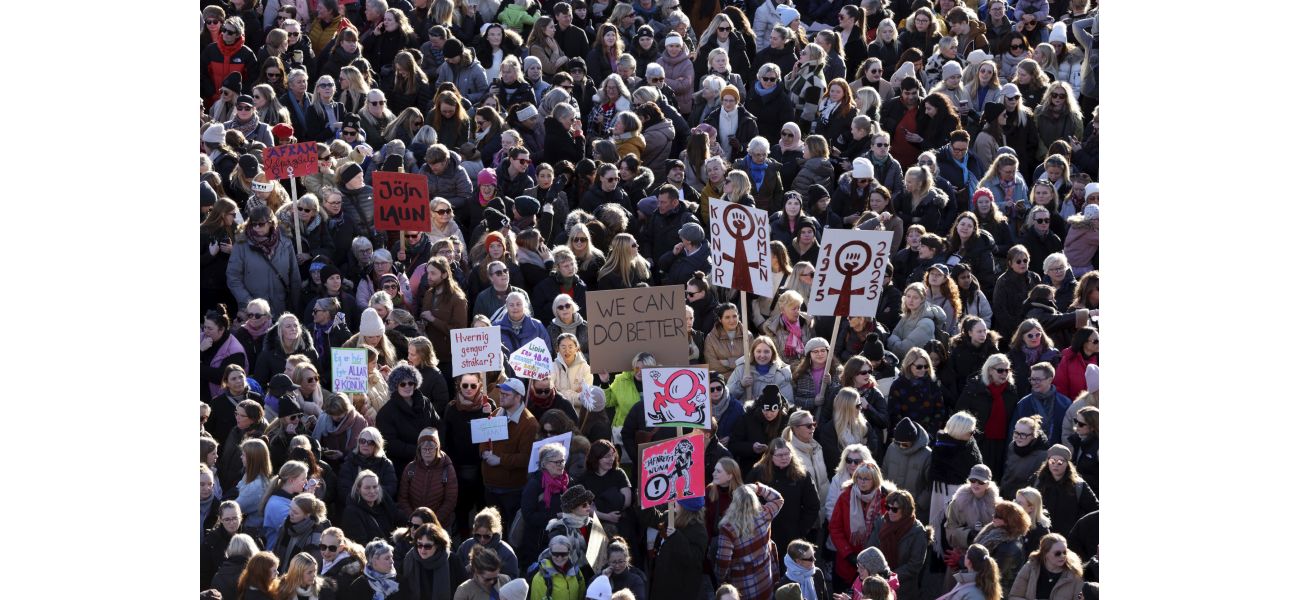Thousands of Icelandic women united in a strike, demanding equal rights and recognition in society.
An army of women refused to work, leading to significant consequences.
October 18th 2024.

In a small country like Iceland, it may seem unusual to see tens of thousands of people in the streets protesting. But on October 24, 2023, that's exactly what happened. The suburban streets were eerily quiet, with schools closed, swimming pools deserted, and even banks shutting early. This was because the majority of women in Iceland had decided to take a stand against unequal pay and gender-based violence by participating in kvennafrí, also known as Women's Day Off.
As the morning news announced the widespread shutdowns, it became clear that this was not just a small gathering. Buses were delayed, hospitals were understaffed, and hotel rooms were left uncleaned, all due to the 100,000-strong group of women and non-binary people who had come together to demand change. By the afternoon, a sea of people had gathered in Reykjavík's city center, armed with signs and singing feminist songs.
One of the organizers, Dr. Finnborg Salome Steinþórsdóttir, was initially nervous that no one would show up to support the cause. But as more and more people arrived, she felt a sense of solidarity in the air. "We had 1,000 people alone from the university in the end," she recalls. "I remember taking a photo as we walked towards downtown Reykjavík – we took up the entire street!"
The issues at the heart of this protest were all too real for the women of Iceland. In 2022, women on average earned 21% less than men, and many were forced to work part-time due to childcare commitments. On top of that, a shocking 40% had experienced gender-based assault or harassment. The protesters were determined to bring attention to these injustices and to challenge the undervaluation of women's work, particularly in fields traditionally seen as "female."
Even the country's leaders, including Prime Minister Katrín Jakobsdóttir and First Lady Eliza Reid, joined in the protest by refusing to work for the day. Among the sea of signs and banners was Finnborg's own, which read "actions immediately" in Icelandic. Others read "Kallarðu þetta jafnrétti?" or "You call this equality?"
This was not the first time Icelandic women had taken to the streets to demand change. In 1975, a similar protest known as the "Women's Day Off" sparked a revolution. Despite having the right to vote, education, and run for public office, women were still hugely underrepresented in Iceland's parliament. In response, a movement called the "Red Stockings" organized a massive protest on October 24, 1975. The protest was named "Women's Day Off" instead of "Women's Strike" to avoid retaliation from employers.
The impact of the 1975 protest was felt for decades to come. By 1983, women held 15% of parliamentary seats, compared to just 5% a decade before. In 1980, Vigdís Finnbogadóttir made history by becoming the world's first democratically elected female president. This was a significant moment for Kristín Ástgeirsdóttir, a 22-year-old history student at the time, who had grown up in a fishing community in Iceland.
"It was like a wave," Kristín recalls. "Women would ask each other 'are you going?' at work or on the street. The word spread. On the day, around 2pm, we started streaming down the streets to this meeting. To see all those women, to feel the energy, it was fantastic."
As the day passed, women gave speeches and sang songs, and even a brass band performed the theme tune to the BBC series "Shoulder to Shoulder," about the Suffragette movement. It was estimated that 90% of the nation's women had participated in the protest, while men took on childcare duties and household tasks. The impact was felt in supermarkets, where the popular smoked sausage Bjúga ran out, and even in rural towns where radio presenters called to ask if women were taking part.
The legacy of the 1975 Women's Day Off lives on, inspiring future generations of women to continue fighting for equality. As Kristín reflects on her experience, she says, "Seeing and hearing the discussion around Finnbogadóttir – she was divorced, she had adopted a child, she had had cancer – made me so angry. Some men thought it was impossible for a woman like that to be in power. But she did win, and that was fantastic. It meant a lot for the next generation of women to see a woman in this top position."
The streets of Iceland were eerily quiet on October 24, 2023. It seemed as though the entire country had come to a standstill. Schools, swimming pools, and even banks were closed for the day. The reason? Tens of thousands of women and non-binary individuals had joined forces for a protest known as kvennafrí, or Women's Day Off, to demand an end to unequal pay and gender-based violence.
News of the protest had spread like wildfire, with all-male news teams announcing shutdowns across the country. Buses were delayed, hospitals were understaffed, and hotel rooms remained uncleaned. As the day went on, a massive group gathered in downtown Reykjavík, with a sea of signs and voices raised in protest. One of the songs sung was 'Áfram Stelpur', which translates to 'Now women mass together and carry signs of freedom; the time has come, let's all stand hand in hand and firmly stand our ground. Even though many want to go backwards and others stand in place; we will never accept that.'
Among the protesters was Dr. Finnborg Salome Steinþórsdóttir, a gender studies researcher who had been nervously waiting outside the University of Iceland. She had reached out to colleagues through Facebook and emails, but was worried that no one would show up. However, as more and more people arrived, her fears were put to rest. "We had 1,000 people from the university alone in the end," she recalls. "I remember taking a photo as we walked towards downtown Reykjavík – we took up the entire street! There was a sense of solidarity in the air."
The issues at the heart of the protest were all too real for the women of Iceland. According to Statistics Iceland, women earned 21% less than men in 2022, and a third of them worked part-time due to childcare commitments. On top of that, 40% had experienced gender-based assault or harassment. The protesters were determined to address these issues head on.
As the day went on, the group marched around Tjörnin lake and took over the streets of Reykjavík. They were following in the footsteps of a similar protest that had taken place in 1975, which had sparked a revolution. Back then, women in Iceland had the right to vote, get an education and run for public office, but were still hugely underrepresented in the Parliament. In response, a movement called the 'Red Stockings' emerged in 1970.
In 1975, during the United Nations 'Women's Year', the Red Stockings organized a protest known as 'Women's Day Off'. The goal was to get men to listen to their concerns by having women stop working for the day. They even changed the name from 'Women's Strike' to 'Women's Day Off' to avoid the risk of women being fired by employers. Stickers with the words 'Women's Day Off' could be seen everywhere, from clothing and handbags to walls and windows. And on October 24, 1975, an estimated 90% of the nation's women participated in the protest.
Kristín Ástgeirsdóttir, a 22-year-old history student at the University of Iceland, was one of those women. She remembers the excitement and energy leading up to the protest, with women asking each other if they were going to participate. "On the day, around 2pm, we started streaming down the streets to this meeting. To see all those women, to feel the energy, it was fantastic," she says.
As the day went on, women gave speeches and sang songs, with a brass band even playing the theme tune to 'Shoulder to Shoulder', a popular BBC series about the Suffragette movement. It was estimated that 30,000 women, or 90% of the nation's female population, took part in the protest. Meanwhile, men took on childcare duties and even took their children to work. Supermarkets ran out of easy-to-prepare foods, telephone switchboards were unmanned, and fish factories were forced to close as most of the workers were female.
But did the protest make a difference? It certainly did. By 1983, women held 15% of parliamentary seats, a significant increase from just 5% a decade before. And in 1980, Vigdís Finnbogadóttir made history by becoming the world's first democratically elected female president. For Kristín, who was a journalist at the time, seeing a woman in such a high position of power was a turning point. "Some men thought it was impossible for a woman like that to be in power. But she did win and that was fantastic, it meant a lot for the next generation of women to see a woman in this top position," she says.
As the morning news announced the widespread shutdowns, it became clear that this was not just a small gathering. Buses were delayed, hospitals were understaffed, and hotel rooms were left uncleaned, all due to the 100,000-strong group of women and non-binary people who had come together to demand change. By the afternoon, a sea of people had gathered in Reykjavík's city center, armed with signs and singing feminist songs.
One of the organizers, Dr. Finnborg Salome Steinþórsdóttir, was initially nervous that no one would show up to support the cause. But as more and more people arrived, she felt a sense of solidarity in the air. "We had 1,000 people alone from the university in the end," she recalls. "I remember taking a photo as we walked towards downtown Reykjavík – we took up the entire street!"
The issues at the heart of this protest were all too real for the women of Iceland. In 2022, women on average earned 21% less than men, and many were forced to work part-time due to childcare commitments. On top of that, a shocking 40% had experienced gender-based assault or harassment. The protesters were determined to bring attention to these injustices and to challenge the undervaluation of women's work, particularly in fields traditionally seen as "female."
Even the country's leaders, including Prime Minister Katrín Jakobsdóttir and First Lady Eliza Reid, joined in the protest by refusing to work for the day. Among the sea of signs and banners was Finnborg's own, which read "actions immediately" in Icelandic. Others read "Kallarðu þetta jafnrétti?" or "You call this equality?"
This was not the first time Icelandic women had taken to the streets to demand change. In 1975, a similar protest known as the "Women's Day Off" sparked a revolution. Despite having the right to vote, education, and run for public office, women were still hugely underrepresented in Iceland's parliament. In response, a movement called the "Red Stockings" organized a massive protest on October 24, 1975. The protest was named "Women's Day Off" instead of "Women's Strike" to avoid retaliation from employers.
The impact of the 1975 protest was felt for decades to come. By 1983, women held 15% of parliamentary seats, compared to just 5% a decade before. In 1980, Vigdís Finnbogadóttir made history by becoming the world's first democratically elected female president. This was a significant moment for Kristín Ástgeirsdóttir, a 22-year-old history student at the time, who had grown up in a fishing community in Iceland.
"It was like a wave," Kristín recalls. "Women would ask each other 'are you going?' at work or on the street. The word spread. On the day, around 2pm, we started streaming down the streets to this meeting. To see all those women, to feel the energy, it was fantastic."
As the day passed, women gave speeches and sang songs, and even a brass band performed the theme tune to the BBC series "Shoulder to Shoulder," about the Suffragette movement. It was estimated that 90% of the nation's women had participated in the protest, while men took on childcare duties and household tasks. The impact was felt in supermarkets, where the popular smoked sausage Bjúga ran out, and even in rural towns where radio presenters called to ask if women were taking part.
The legacy of the 1975 Women's Day Off lives on, inspiring future generations of women to continue fighting for equality. As Kristín reflects on her experience, she says, "Seeing and hearing the discussion around Finnbogadóttir – she was divorced, she had adopted a child, she had had cancer – made me so angry. Some men thought it was impossible for a woman like that to be in power. But she did win, and that was fantastic. It meant a lot for the next generation of women to see a woman in this top position."
The streets of Iceland were eerily quiet on October 24, 2023. It seemed as though the entire country had come to a standstill. Schools, swimming pools, and even banks were closed for the day. The reason? Tens of thousands of women and non-binary individuals had joined forces for a protest known as kvennafrí, or Women's Day Off, to demand an end to unequal pay and gender-based violence.
News of the protest had spread like wildfire, with all-male news teams announcing shutdowns across the country. Buses were delayed, hospitals were understaffed, and hotel rooms remained uncleaned. As the day went on, a massive group gathered in downtown Reykjavík, with a sea of signs and voices raised in protest. One of the songs sung was 'Áfram Stelpur', which translates to 'Now women mass together and carry signs of freedom; the time has come, let's all stand hand in hand and firmly stand our ground. Even though many want to go backwards and others stand in place; we will never accept that.'
Among the protesters was Dr. Finnborg Salome Steinþórsdóttir, a gender studies researcher who had been nervously waiting outside the University of Iceland. She had reached out to colleagues through Facebook and emails, but was worried that no one would show up. However, as more and more people arrived, her fears were put to rest. "We had 1,000 people from the university alone in the end," she recalls. "I remember taking a photo as we walked towards downtown Reykjavík – we took up the entire street! There was a sense of solidarity in the air."
The issues at the heart of the protest were all too real for the women of Iceland. According to Statistics Iceland, women earned 21% less than men in 2022, and a third of them worked part-time due to childcare commitments. On top of that, 40% had experienced gender-based assault or harassment. The protesters were determined to address these issues head on.
As the day went on, the group marched around Tjörnin lake and took over the streets of Reykjavík. They were following in the footsteps of a similar protest that had taken place in 1975, which had sparked a revolution. Back then, women in Iceland had the right to vote, get an education and run for public office, but were still hugely underrepresented in the Parliament. In response, a movement called the 'Red Stockings' emerged in 1970.
In 1975, during the United Nations 'Women's Year', the Red Stockings organized a protest known as 'Women's Day Off'. The goal was to get men to listen to their concerns by having women stop working for the day. They even changed the name from 'Women's Strike' to 'Women's Day Off' to avoid the risk of women being fired by employers. Stickers with the words 'Women's Day Off' could be seen everywhere, from clothing and handbags to walls and windows. And on October 24, 1975, an estimated 90% of the nation's women participated in the protest.
Kristín Ástgeirsdóttir, a 22-year-old history student at the University of Iceland, was one of those women. She remembers the excitement and energy leading up to the protest, with women asking each other if they were going to participate. "On the day, around 2pm, we started streaming down the streets to this meeting. To see all those women, to feel the energy, it was fantastic," she says.
As the day went on, women gave speeches and sang songs, with a brass band even playing the theme tune to 'Shoulder to Shoulder', a popular BBC series about the Suffragette movement. It was estimated that 30,000 women, or 90% of the nation's female population, took part in the protest. Meanwhile, men took on childcare duties and even took their children to work. Supermarkets ran out of easy-to-prepare foods, telephone switchboards were unmanned, and fish factories were forced to close as most of the workers were female.
But did the protest make a difference? It certainly did. By 1983, women held 15% of parliamentary seats, a significant increase from just 5% a decade before. And in 1980, Vigdís Finnbogadóttir made history by becoming the world's first democratically elected female president. For Kristín, who was a journalist at the time, seeing a woman in such a high position of power was a turning point. "Some men thought it was impossible for a woman like that to be in power. But she did win and that was fantastic, it meant a lot for the next generation of women to see a woman in this top position," she says.
[This article has been trending online recently and has been generated with AI. Your feed is customized.]
[Generative AI is experimental.]
0
0
Submit Comment





